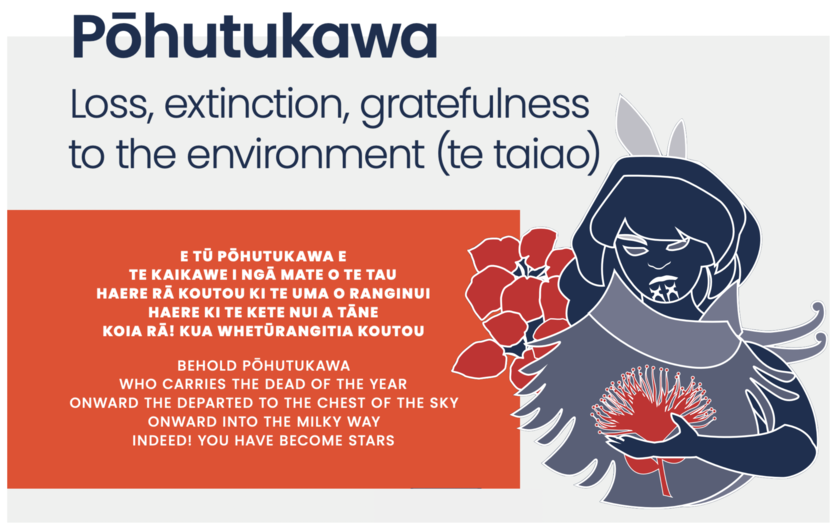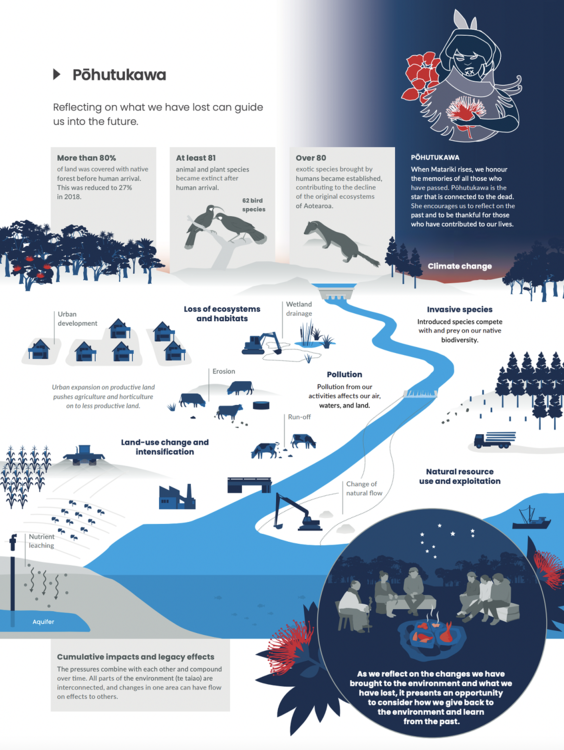Pōhutukawa is a whetū in the Matariki cluster. It is connected to those who have passed since Matariki the previous year. Pōhutukawa prompts us to reflect on and be thankful for the past year.
Aotearoa New Zealand’s Ministry for the Environment and Stats NZ have produced Environment Aotearoa 2022 as part of its environmental reporting series. Environment Aotearoa 2022 has a unique approach that uses Te Kāhui o Matariki as the guiding framework for the report. Learn more about this approach in the article Environment Aotearoa 2022 – introduction.
In Environment Aotearoa 2022, Pōhutukawa represents the species and ecosystems that we have lost and are at risk of losing. When a species is gone, its mauri is lost, and we are left with its memory and the lessons we can take from its departure from an ecosystem or its extinction. As humans, we are connected with the natural world, and the loss of any part of the environment can have a negative impact on our wellbeing.
Pōhutukawa also represents the appreciation and duty of care we have for te taiao (the environment). To honour this, we need to acknowledge the pressures we put on the environment and plan on how we can reduce them.
Pressures on te taiao
The pressures that have the biggest impacts on the environment are:
- land use change and intensification
- loss of ecosystems and habitats
- invasive (pest) species
- pollution
- use and overuse of natural resources
- climate change.
For centuries, humans have modified the land to fulfil our needs for food, shelter and commerce. Farming – first by Māori, then by early European settlers – quickly became the backbone of Aotearoa New Zealand’s economy. Changing the land from its original state (native forest, wetlands or tussock land for example) can create significant impacts. Habitats and ecosystems may be destroyed or altered. The intensification of agricultural, horticultural and exotic forestry may require the use of fertilisers and irrigation to boost production. When city fringes expand onto highly productive land, it forces those who grow our food onto less-productive land, creating the need for even more fertiliser and irrigation.
Changes in the way we use the land allows invasive (pest) species to spread. The threat from introduced plants and animals is one of the greatest pressures on our native species and ecosystems. When taonga species are threatened, this has impacts on tikanga and mātauranga Māori. Invasive species also have economic effects, particularly on food production.
Land use change and intensification in cities and rural areas creates pollution by adding eroded sediments and nutrients to waterways and marine environments. Aotearoa and the world are also grappling with growing amounts of plastic waste.
We’ve long used te taiao as a treasure chest and exploited the natural resources it has to offer. Our diversion of water for electricity generation, urban needs, irrigation and flood control has altered the flow patterns of waterways. This impacts the mauri of the waterways and the people who live near them.
Overshadowing all of this is climate change. As all aspects of te taiao are interconnected, climate change can increase the pressures te taiao is already experiencing. For example, in marine ecosystems, marine heatwaves caused by climate change can reduce the population of native species. This creates empty spaces that are colonised by non-natives. Warmer temperatures have reduced the volume of ice in our glaciers, which in turn reduces the water available for the awa they feed.
Caring for te taiao
It’s not all doom and gloom. Pōhutukawa also represents the duty of care we have for te taiao. Reports like Environment Aotearoa 2022 show that we have a good understanding of the pressures we’ve placed on the environment. Many of the pressures are wicked problems – a mix of environmental, economic and political issues. The wealth of evidence and data from both mātauranga and science are leading to changes in how we interact with and value te taiao.
The way we view nature, and the subsequent choices in the ways we live and make a living, result in pressures on the environment. These pressures can result in the loss of ecosystems and species, negatively impacting different aspects of our wellbeing. Our duty of care is therefore to acknowledge the pressures we put on the environment and plan on how we can reduce them.
Environment Aotearoa 2022
Innovations in the dairy sector are targeting climate change and water quality issues. The horticulture sector is also addressing its impacts. Consumers in Aotearoa and overseas are becoming increasingly aware of good-quality environmental practices, so it makes economic sense to reduce pressures on the land. Businesses and the general public are increasing investment in renewable energy sources and cleaner transport.
It’s not just up to the government and businesses to care for te taiao – this duty belongs to all of us. There are small steps that we can all take, from reducing food waste and unnecessary car trips to helping out with community planting initiatives.
Related content
Environmental pressures are often wicked problems or socioscientific issues that involve environmental, economic or political issues or combinations of these. This article provides excellent pedagogical information about using wicked problems as an opportunity for inquiry and cross-curricular and key competency learning.
Exploring and acting on our duty of care is an ideal context for educators wishing to develop a local curriculum and/or embed mātauranga Māori into the science classroom. The recorded webinar Local curriculum, mātauranga and science offers practical support and resources.
The recorded webinar Tame Malcolm – indigenous pest management explores te ao Māori views and values on pest control.
Nature – a context for learning explores the links between te taiao and wellbeing and te ao Māori perspectives and curates resources for learning about and protecting our local environment.
Planning pathways provide a gateway to collections of articles, multimedia, student activities and stories of New Zealand’s science research.
- Thinking about plastic
- Climate change
- Conservation
- Love Rimurimu (seaweed conservation and restoration)
- Takahē (native bird conservation and recovery)
The Science Learning Hub team has curated a collection of resources to support Matariki and Environment Aotearoa 2022. This collection provides additional context and pedagogical insights. Log in to make this collection part of your private collection, just click on the copy icon. You can then add additional content and notes and make other changes.
Useful link
Stats NZ and the Ministry for the Environment report on different aspects of Aotearoa New Zealand’s environment every 6 months. Access their reports here.
Acknowledgement
This resource has been produced in collaboration with the Ministry for the Environment and Stats NZ.



